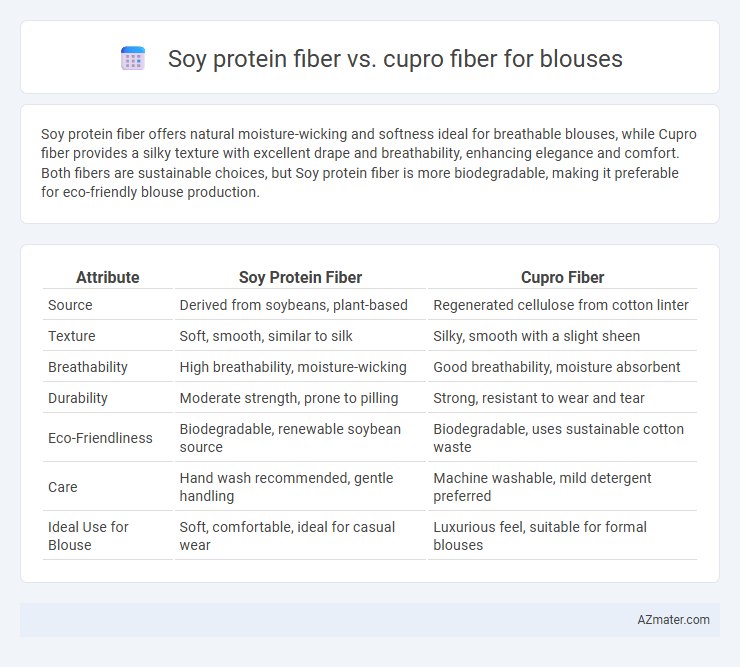Soy protein fiber offers natural moisture-wicking and softness ideal for breathable blouses, while Cupro fiber provides a silky texture with excellent drape and breathability, enhancing elegance and comfort. Both fibers are sustainable choices, but Soy protein fiber is more biodegradable, making it preferable for eco-friendly blouse production.
Table of Comparison
| Attribute | Soy Protein Fiber | Cupro Fiber |
|---|---|---|
| Source | Derived from soybeans, plant-based | Regenerated cellulose from cotton linter |
| Texture | Soft, smooth, similar to silk | Silky, smooth with a slight sheen |
| Breathability | High breathability, moisture-wicking | Good breathability, moisture absorbent |
| Durability | Moderate strength, prone to pilling | Strong, resistant to wear and tear |
| Eco-Friendliness | Biodegradable, renewable soybean source | Biodegradable, uses sustainable cotton waste |
| Care | Hand wash recommended, gentle handling | Machine washable, mild detergent preferred |
| Ideal Use for Blouse | Soft, comfortable, ideal for casual wear | Luxurious feel, suitable for formal blouses |
Introduction to Sustainable Blouse Fabrics
Soy protein fiber, derived from natural soybean residues, offers eco-friendly properties such as biodegradability, moisture-wicking, and a soft, silk-like texture ideal for sustainable blouse fabrics. Cupro fiber, regenerated from cotton linter, provides breathability, biodegradability, and a smooth, luxurious feel, making it another sustainable choice for eco-conscious blouse designs. Both fibers contribute to reducing environmental impact through renewable sourcing and reduced chemical processing compared to conventional fabrics.
What is Soy Protein Fiber?
Soy protein fiber is a biodegradable, eco-friendly textile made from soybean protein, known for its softness, breathability, and moisture-wicking properties, making it ideal for blouses that require comfort and durability. It offers natural antibacterial benefits and excellent dye affinity, resulting in vibrant colors and a smooth, silk-like texture. Compared to Cupro fiber, soy protein fiber provides superior elasticity and a more sustainable production process, appealing to eco-conscious fashion brands.
Understanding Cupro Fiber
Cupro fiber, a regenerated cellulose fabric made from cotton linter, offers exceptional breathability, a silky texture, and excellent moisture absorption, making it ideal for blouses with a luxurious feel. Compared to soy protein fiber, which is derived from soybean residues and provides natural elasticity and softness, cupro stands out for its smooth drape and hypoallergenic properties. Cupro fiber's biodegradability and ability to blend seamlessly with other fibers ensure both comfort and sustainability in high-quality blouse fabrics.
Production Process: Soy Protein Fiber vs Cupro
Soy protein fiber is produced by extracting protein from defatted soybeans, which is then dissolved, extruded, and regenerated into fibers through a dry-spinning process, yielding a biodegradable and eco-friendly fabric. Cupro fiber, derived from regenerated cellulose, is produced by treating cotton linter with cuprammonium solution, followed by spinning and oxidation, offering a silky texture with excellent breathability. The production of soy protein fiber emphasizes sustainable use of agricultural byproducts, while cupro relies on chemical processing of cotton waste, impacting environmental and cost factors in blouse manufacturing.
Environmental Impact Comparison
Soy protein fiber, derived from soybeans, offers a biodegradable and renewable alternative with lower water consumption and reduced chemical use compared to synthetic fibers. Cupro fiber, produced from cotton linter cellulose, provides a more sustainable option than conventional viscose by utilizing agricultural waste but requires chemical-intensive processing that can impact water quality. Both fibers contribute to eco-friendly blouse production, yet soy protein fiber generally has a smaller overall environmental footprint due to its lower resource demand and biodegradability.
Comfort and Feel: Which Fabric Wins?
Soy protein fiber offers exceptional softness and breathability, making it highly comfortable for blouses worn close to the skin. Cupro fiber, derived from cotton linter, provides a silky, smooth texture with excellent moisture absorption that enhances comfort in warm conditions. Between the two, Cupro achieves a luxurious feel with superior drape, while soy protein fiber excels in natural softness and eco-friendliness, positioning both as top choices depending on the comfort preference.
Durability and Care Requirements
Soy protein fiber exhibits excellent durability with strong resistance to abrasion and stretching, making it ideal for long-lasting blouse fabrics. Cupro fiber, made from regenerated cellulose, offers moderate durability but requires gentle care such as hand washing or dry cleaning to maintain fabric integrity. Both fibers provide breathability and softness, but soy protein fiber stands out for easier maintenance and higher resilience in everyday wear.
Aesthetic Qualities in Blouse Design
Soy protein fiber offers a silky, smooth texture with excellent drape, creating elegant and breathable blouses ideal for warm weather. Cupro fiber provides a lustrous, satin-like finish with a soft handfeel, enhancing the blouse's luxurious appearance and vibrant color retention. Both fibers lend a high-end, refined aesthetic, but Cupro's natural sheen makes it particularly suited for sophisticated, polished blouse designs.
Price Comparison and Accessibility
Soy protein fiber is generally more affordable than Cupro fiber, making it a cost-effective choice for blouse manufacturing. Cupro fiber, derived from cotton linter, tends to be pricier due to its complex production process and limited supply. Accessibility-wise, soy protein fiber has broader availability in markets prioritizing sustainable materials, while Cupro fiber remains niche, often limited to specialized textile suppliers.
Final Verdict: Choosing the Right Fabric for Blouses
Soy protein fiber offers excellent moisture absorption, softness, and biodegradability, making it a preferred choice for comfortable, eco-friendly blouses. Cupro fiber provides a luxurious silky texture, superior breathability, and natural sheen, ideal for elegant, high-end blouse designs. Selecting between soy protein and cupro depends on prioritizing either sustainable comfort or refined aesthetic appeal for the perfect blouse fabric.

Infographic: Soy protein fiber vs Cupro fiber for Blouse
 azmater.com
azmater.com